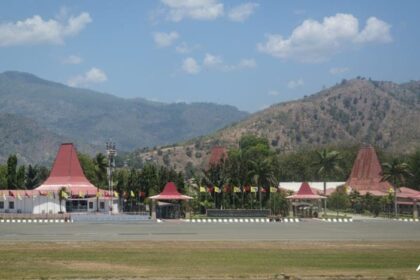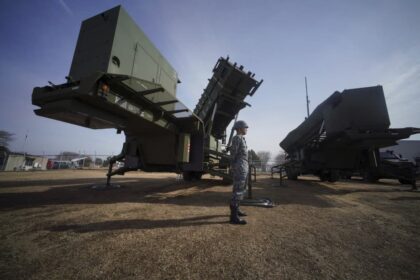Why Starlink matters in a Taiwan conflict
Chinese defense researchers have modeled how to suppress SpaceX Starlink across an area the size of Taiwan. Their conclusion is blunt: it may be technically feasible, but only with a very large electronic warfare force composed of hundreds, and more likely thousands, of airborne jamming platforms. The study describes Starlink as a moving target that adapts in real time, a system that frustrates many traditional tactics used against satellite links.
Starlink operates with more than ten thousand satellites in low Earth orbit. User terminals on the ground constantly switch between satellites that move across the sky. Signals hop, routes change, and the network shifts traffic around disruptions. That mobility and agility make it difficult for any single jammer to overpower the link for long. Conventional ground based jamming that works against a few stationary satellites offers little assurance against a large, fast changing constellation.
The study’s baseline scenario calls for at least 935 synchronized airborne jammers to fully suppress Starlink signals over Taiwan. If lower power emissions are used, the number rises toward two thousand platforms to close gaps and maintain coverage. Wartime experience in Ukraine shaped this focus. Russian forces tried to interfere with Starlink, and SpaceX repeatedly updated software and network settings to keep terminals online. The resilience of those links helped Ukraine preserve command and control during the opening months of the invasion, an outcome that has drawn close attention in Beijing.
How the constellation complicates jamming
Older communication satellites often sit in geostationary orbit, appearing fixed over the equator. A jammer can aim at a known point in the sky or overpower the downlink over a specific footprint. Starlink behaves very differently. Dozens of satellites can be in view at any one time. Terminals hand off traffic with little warning. Links change frequency, direction, and routing. A jammer that momentarily disrupts one path may not block the next one that appears seconds later.
Low Earth orbit and moving targets
Starlink satellites circle the planet at low altitude. Their fast motion means the set of satellites visible from any ground location changes every few minutes. A single terminal rarely talks to one satellite for long. Instead, it hops across a set of satellites that rise and set across the horizon. This geometry introduces constant uncertainty for an attacker: where to aim, how much power to use, and when to switch targets. Any delay in reacting to a handoff can reopen a viable link for the user.
Frequency agility and beam forming
Starlink’s terminals and satellites use agile waveforms and directional antennas to focus energy where it is needed. Phased array hardware can steer beams electronically, which helps reject interference outside the main lobe. The network can also shift channels and adjust coding schemes to maintain a usable signal. Many satellites backhaul traffic through optical crosslinks, which do not emit radio energy, shrinking the number of radio frequency points that a jammer can attack. To succeed, a jamming plan must depress the signal quality below a usable threshold for as many terminals as possible, at all times, across a wide area that includes varied terrain.
What the Chinese simulation modeled
The study, published in the journal Systems Engineering and Electronics by a team that includes researchers from Beijing Institute of Technology and Zhejiang University, evaluated how to deny Starlink service over territory comparable to Taiwan, an island of roughly 36,000 square kilometers. The team simulated satellite passes and terminal visibility over a 12 hour window. The goal was to reduce the signal to the point that user terminals could not hold a link, even as satellites shifted overhead and the network tried to reroute traffic.
Rather than rely on a handful of large ground transmitters, the researchers proposed a fully distributed plan: many smaller, synchronized jammers carried by drones, balloons, or aircraft. Airborne placement brings the jammer closer to terminals, reduces signal loss through terrain and buildings, and allows flexible positioning. By coordinating power levels, antenna patterns, and timing, the platforms could form an electromagnetic barrier over the target area.
Drone swarms as jamming platforms
In the model, each jammer is an airborne node that emits noise to overwhelm Starlink’s downlink at the user terminal. A swarm can reposition to fill coverage holes, reinforce weak spots, or shift toward emerging hotspots. This requires precise timing so that nodes do not interfere with each other or leave gaps. It also demands robust command and control for the swarm itself, since any loss of coordination would quickly create windows where terminals can reconnect.
Power, spacing, and coverage
The simulation compared different antenna choices. Wide beam antennas cover more area with lower energy in any one direction, while narrow beam antennas deliver stronger energy on target but require accurate pointing. The team found that to maintain suppression across the island, a baseline of at least 935 synchronized platforms was needed. Using lower power emitters, around 23 dBW of radiated power per platform (about 200 watts), raised the total to roughly two thousand airborne units to achieve similar effects. The model accounted for the changing number of satellites in view and the constant terminal handoffs across the constellation.
Can the PLA scale this in a real fight
Generating the required mass is the central challenge. Fielding more than a thousand synchronized airborne jammers would demand large inventories of expendable drones or survivable aircraft, trained operators, and an automation layer to choreograph movement, timing, and spectrum use. The force would need to keep a stable formation through losses, weather, and battery or fuel constraints, and it would need spares to replace downed platforms.
Survivability is another hurdle. Taiwan and supporting forces would contest the airspace with radar, surface to air missiles, anti drone weapons, and their own electronic warfare. A large, slow moving jamming layer would invite interception. Keeping platforms at higher altitude reduces terrain masking and improves line of sight, but it also exposes them to longer range air defenses. Flying low helps hide behind hills and buildings, but increases the number of platforms required and the risk of gaps.
Countermeasures would also evolve. Taiwan and partners could harden terminals, narrow receive beams, and use better filters. They could shift to alternative frequencies, adopt low probability of intercept techniques, or change modem settings to stay connected at lower signal quality. SpaceX can push software updates rapidly across terminals, as seen in Ukraine. Any plan that appears effective in early engagements might degrade as the defender adapts.
Command and control for the jammer swarm presents its own burden. The attacker must coordinate frequencies and waveforms across thousands of emitters while avoiding self interference and protecting its own communications. Sorting those tasks in congested spectrum, under fire, is a daunting prospect.
How Taiwan can stay connected under attack
Planning for communication resilience does not rely on a single system. Analysts have urged Taiwan to build redundancy across space, air, and ground. That means buying time on multiple low Earth orbit constellations, prepositioning terminals, and training operators to switch between systems. It also means retaining independent radio networks and building habits that keep essential traffic flowing even when capacity is constrained.
- Secure access to multiple satellite providers, including low Earth orbit and medium Earth orbit options, with contracts and hardware prepositioned.
- Distribute terminals across agencies, utilities, and first responders, with power supplies, camouflage materials, and spare parts stored in multiple locations.
- Harden antenna sites, use directional antennas, and employ emission control to reduce detection.
- Maintain alternate paths such as high frequency radio, satellite phones, microwave relays, and portable mesh networks that can bridge short distances when satellite links falter.
- Use aerial relays, including tethered balloons or aircraft, to restore local connectivity if ground networks are damaged.
- Practice failover procedures during peacetime, including public communication drills and continuity plans for critical services.
- Work with partners to secure surge capacity on allied networks and to coordinate interference mitigation.
Diversified connectivity makes a jammer’s job harder. If one path degrades, traffic can shift to another. Reliable power, disciplined terminal use, and trained operators can preserve essential services even when bandwidth is scarce.
Beyond jamming, talk of physical attacks
Some Chinese research has explored strategies to physically disable parts of a large constellation, including concepts that use AI for coordinated targeting by satellites equipped with directed energy or other systems. These studies focus on how to identify key satellites and disrupt service with smaller forces by striking nodes that carry the most traffic. Such work remains theoretical and faces enormous engineering, legal, and strategic constraints.
Any attempt to harm satellites risks debris creation that can damage spacecraft belonging to many countries. International norms discourage kinetic anti satellite actions for that reason. Directed energy concepts avoid debris but require large power, precise pointing, and favorable geometry. Pursuing these paths would sharply raise tensions and could draw wider responses. Jamming, while still escalatory, is reversible and does not leave long lasting debris.
What we still do not know
Key parts of Starlink’s anti jamming approach are not public. Military grade variants and services exist, and the company continues to add satellites and update software. Terminals vary in capability, and many can receive highly directional beams that reject interference from unwanted angles. The defender can also reconfigure routing through optical crosslinks to keep traffic away from contested radio segments.
The Chinese simulation is informative, but its authors caution that their findings are preliminary. Any model depends on assumptions about signal strength, terminal density, and defender behavior. Real battle conditions involve terrain, weather, attrition, and rapid adaptation on both sides. As the constellation grows and its software evolves, a jammer must scale its force just to keep pace.
Key Points
- Chinese researchers modeled a plan to jam Starlink across an area the size of Taiwan.
- The study finds suppression is possible only with a very large force of airborne jammers.
- At least 935 synchronized platforms would be needed, rising to about 2,000 with lower power emitters.
- Starlink’s moving satellites, frequency agility, and directional beams complicate any jamming plan.
- The approach relies on drones, balloons, or aircraft to create an electromagnetic barrier over the island.
- Scaling, survivability, and coordination would be major challenges in a real conflict.
- Taiwan can reduce risk by diversifying satellite access, hardening terminals, and practicing failover across multiple networks.
- Other Chinese studies discuss physical disruption concepts, though these are theoretical and highly escalatory.
- Unknowns remain, including classified anti jamming features and how quickly both sides could adapt.












